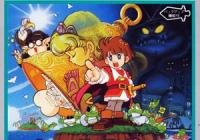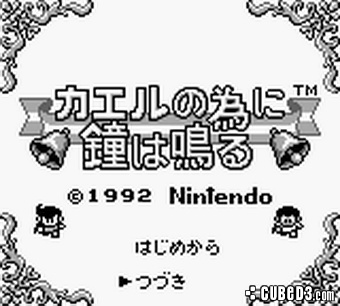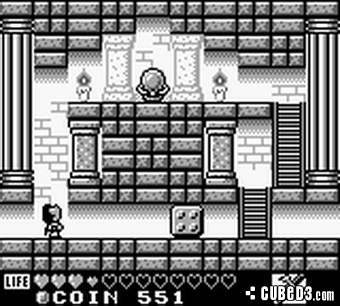Kaeru no Tame ni Kane wa Naru (Game Boy) Review
By Rudy Lavaux  12.08.2015
12.08.2015

Kaeru no Tame ni Kane wa Naru, translated to For the Frog the Bell Tolls, was released exclusively in Japan for the Game Boy in 1992. It was developed by Nintendo's R&D 1 team, the same group responsible for Metroid II: Return of Samus, Super Mario Land 2: 6 Golden Coins, and most importantly The Legend of Zelda: Link's Awakening. Out of all those, For the Frog the Bell Tolls is the only one to not have seen a Western release, yet numerous nods to it are found throughout classic Nintendo games, which tells a great deal about its significance within the Nintendo legacy. It's only natural that fans should want to know what the deal is, all the more so since it received a fan-translation in 2011, making it more accessible to gaijins.
The Prince of Sablé Kingdom (the main protagonist of the adventure, named by the player) is a good friend of Richard, prince of Custard Kingdom. Both are of equal intelligence and value, however there is one area in which the Prince of Sablé could never hold his own against Richard: fencing. As they're training (more like brawling cartoon-style in a cloud of dust-think of Tom & Jerry) a villager interrupts them, bringing ill news that the Croakian Army, led by King Delarin, has invaded the Kingdom of Mille-Feuille, ruled by Princess Tiramisu. Both characters have a romantic interest in the princess and want to sail to her rescue, so Richard leaves the beaten-down Prince of Sablé on the floor to get to his ship and sail away. The protagonist follows after Richard, only to be rebutted out of the ship; Richard says that he alone will rescue princess Tiramisu, obviously hoping to marry her as a result, since Prince Sablé can't fight well and wouldn't stand a chance against the Croakian minions. Not standing for such an affront, the Prince of Sablé spends much of his royal treasure on buying himself a ship and sails after Richard alone. He will spend a good portion of the story building up his power as he explores the Kingdom of Mille-Feuille, gaining in strength through items he picks up.
At its core, For the Frog the Bell Tolls is an RPG-ish adventure. Most of it plays like a Zelda game, though original enough to not be coined a clear copy, and battles occur in a fashion more akin to RPGs. Enemies are seen directly roaming the landscape, and battle is only initiated when the character makes contact with them. Battles unfold automatically, and the outcome is never a result of the player's decisions or inputs (since there are none) and is strictly dependent on how strong the main character is from having picked up a better weapon, a better shield, or collected tokens to increase stats such as speed or strength. Also collectible are heart containers making up the health bar which is, again, very much like Zelda.

Battles are not quite the best part due to their lack of interactivity, but fortunately they're usually over in a matter of a few seconds. Even key battles against boss-like creatures max out around 10 seconds. Characters will usually give hints as to what equipment is required against a boss to stand a chance of winning, which eases even newcomers (young kids in particular) into the game. Indeed, the main demographic of the Game Boy was very much children under the age of 12. As such, For the Frog the Bell Tolls is ideal for easing newcomers into the RPG genre, introducing them to the mechanic of searching for the best equipment to overcome obstacles that would otherwise be insurmountable, and thus progressing further and advancing the story. The narrative itself, written by Yoshio Sakamoto of Metroid fame, is surprisingly well-written and detailed, fleshing out characters more so than probably any Game Boy RPG before it, and featuring lots of humour within themes that anyone can relate to: friendship, competition, trickery, bravery, and romance. As the game progresses, the player is gradually left to figure out certain things on his or her own, forcing them to progress as players as well, which is awesome.
The biggest and most distinctive original concept is transformation. The main character eventually (and sometimes accidentally) gains the power of transforming into a frog, allowing him to swim and explore underwater sections, as well as into a snake, allowing him to fit into tight spots and turn enemies into pushable blocks by biting them. It's all seamlessly introduced within the story, always with a good reason, and used to great effect to make clever puzzle sections. There are only a few areas of light concern in terms of gameplay, such as the character not conserving his direction when coming in and out of houses and villages, forcing the player to let go of the D-Pad and press it again to continue moving in the same direction.

Some actions are also not explained within the game itself but in the original manual, like the possibility to jump higher than normal during side-scrolling sections by holding up, then pressing jump. Overall though, nothing is too tough to figure out that it removes from the fun.
The one title in which the influence of For the Frog the Bell Tolls is the most apparent is The Legend of Zelda: Link's Awakening, one that ranks highly amongst most Zelda fans' favourite outings. First of all, the font used for the text in the original Japanese version is the same for both. The way the world is explored is also similar in many ways. The overworld is viewed from above while a lot of inside locations are viewed from the side, very much like a platformer. In fact, in For the Frog the Bell Tolls, dungeons take place exclusively in that style, bringing it effectively closer to Zelda II: The Adventure of Link in that respect, though only the dungeons are displayed in that way. Exploring a dungeon, especially the main hub one to which the prince has to come back several times over the course of the story, plays very much like the aforementioned Metroid II, with doors being locked until the prince finds the right transformation or item to get past them. The map system is also very similar, except for the fact that it's completely uncovered from the start here, whereas in Zelda it would uncover as the player explores the island. Each "square" on the map corresponds to one screen in the world and can be examined to get the name of the location.

Last but certainly not least, the second main character, Richard, has a role in Link's Awakening as well. In his house in Zelda, a reworked version of the main overworld theme from For the Frog the Bell Tolls is heard and, one can only assume, the frogs seen hopping about must be some of his Custard Kingdom knights transformed into frogs.
Other references to For the Frog the Bell Tolls are found in Super Smash Bros. Brawl, where the Prince of Sablé appears as a sticker, and most prominently in Super Smash Bros. for Nintendo 3DS and Wii U where he is an assist trophy. This indicates how important this piece of software, as obscure as it may seem to people outside of Japan, is to Nintendo nowadays. While the Smash Bros. series has some experience introducing Japanese-exclusive Nintendo properties to Westerners (and some have even come out of Japan afterwards, such as Fire Emblem), Nintendo isn't exactly known for bringing out past releases in translated forms, so hopes for the game to come out on the 3DS Virtual Console outside of Japan are slim to none. A remake could one day make it out of Japan the way Fire Emblem: Shadow Dragon did, but in the meantime, a fan-translation exists and is well-made overall, though without resorting to far more advanced hacking of the original source code, the script had to be greatly summarised to fit within constraints of the original Japanese text. This doesn't take away too much of the fun though, and allows non-Japanese speaking audiences to finally appreciate the title.

Cubed3 Rating
Exceptional - Gold Award

It's hard to figure out why this never received a Western release back in its day. Perhaps the reception in its home turf was deemed too lukewarm, or maybe the battle system was too unconventional to fit Western tastes, or maybe the overall humour was hard to relate to (there is a large amount of puns on purely Japanese things). Or maybe it's a combination of all the aforementioned reasons; maybe the very fact that it was a RPG hampered its release, like so many other Nintendo-developed RPGs, such as Marvelous: Mouhitotsu no Takarajima, Eiji Aonuma's first title as director for the Super Famicom, which suffered the same fate and could be likened to this one in terms of originality and resemblance to Zelda. Nevertheless, this little Game Boy game paved the way for Link's Awakening and is an important part of Nintendo's history of bringing great experiences in handheld form. It plays well as a portable RPG, is enjoyable in short or long sessions, and reflects the same level of quality as other contemporary R&D 1 releases. It's a must-play piece of Nintendo history.

For the Frog the Bell Tolls
![]() 9/10
9/10
![]() 0
(0 Votes)
0
(0 Votes)
 None
None  None
None  Out now
Out now  None
None Comments
Comments are currently disabled

 Sign In
Sign In Game Details
Game Details Subscribe to this topic
Subscribe to this topic Features
Features





 Top
Top

